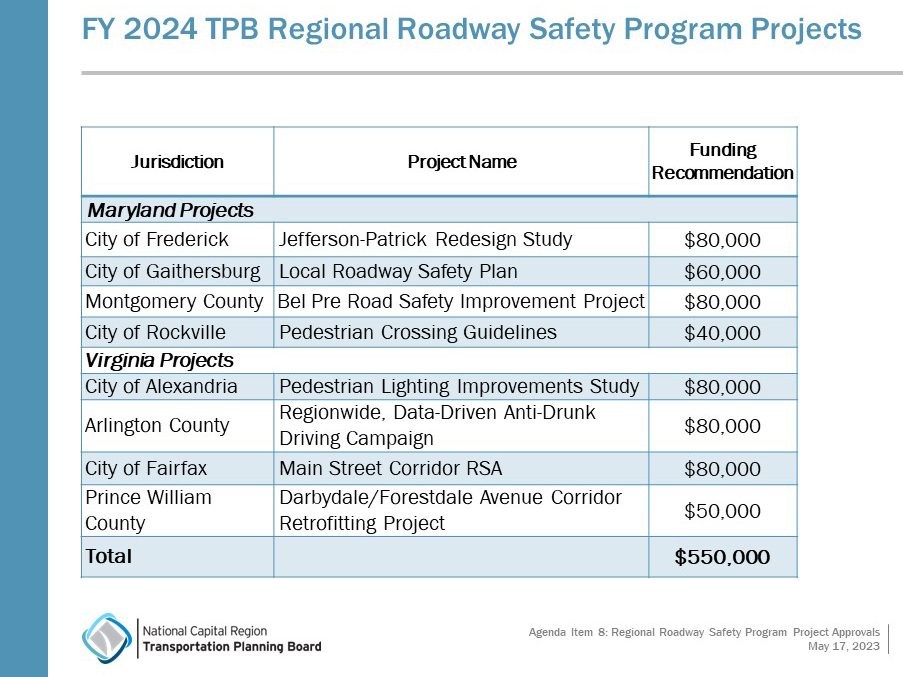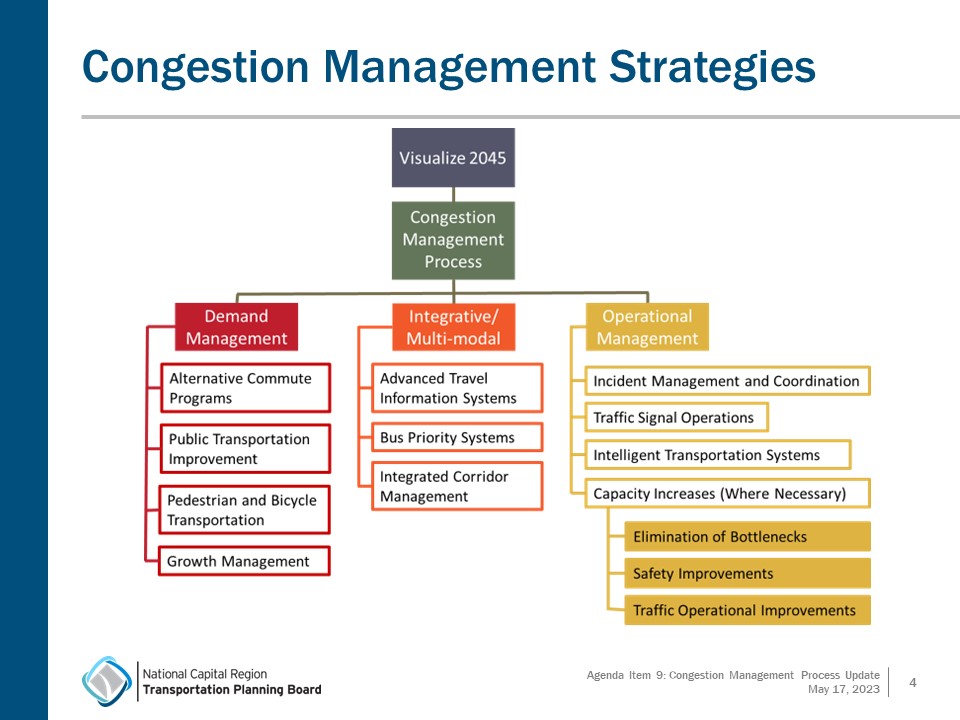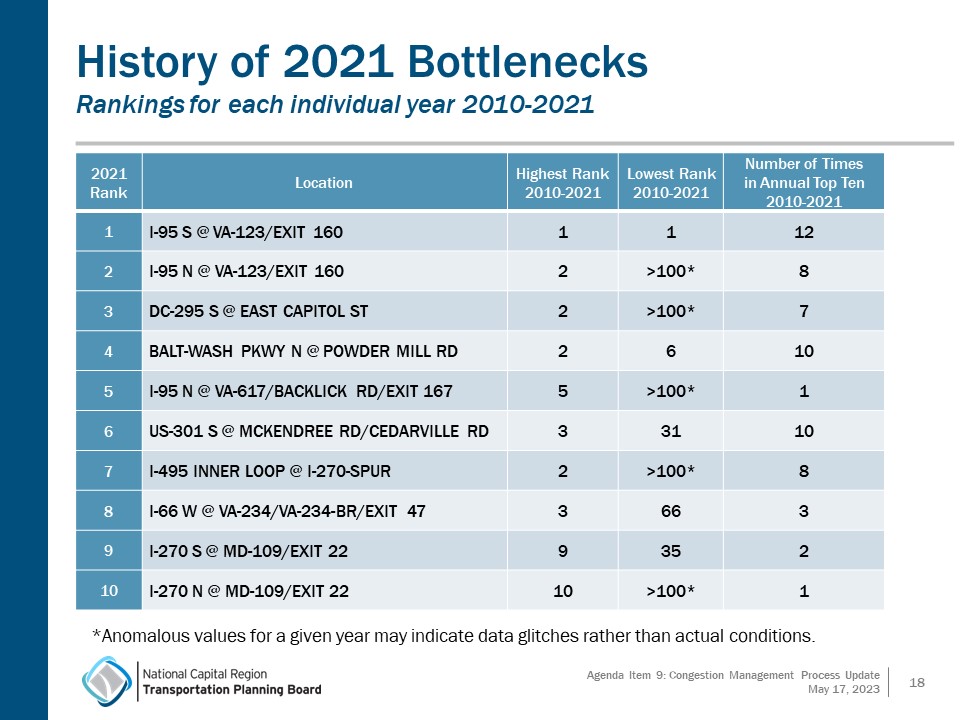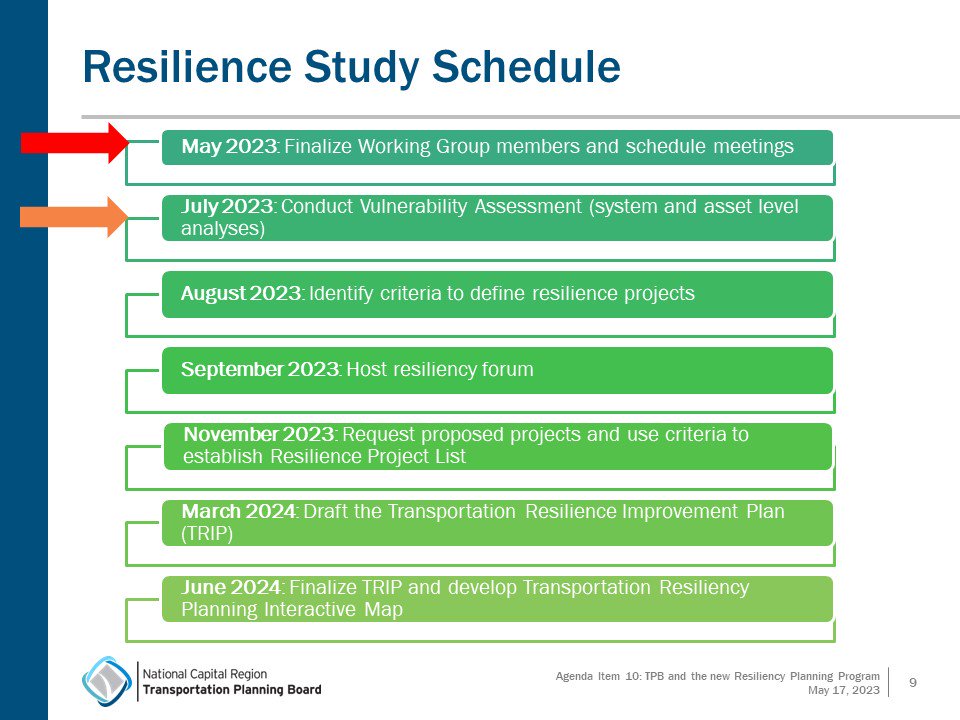At the May TPB meeting, board members approved the 2023 TPB Coordinated Human Service Transportation Plan Update and eight new Regional Roadway Safety Program projects. In addition, they received updates on the TPB's Congestion Management process and heard the latest information on transportation resilience planning.
Meeting agenda, materials, and recording
ACTION ITEMS
Coordinated Human Service Transportation Plan Update
Board members adopted Resolution R11-2023 approving the 2023 update to the Coordinated Human Service Transportation Plan. COG is required by the Federal Transit Administration (FTA) to update the plan every four years with input from TPB’s Access for All (AFA) Committee and members of impacted populations: older adults, people with disabilities, and those with low incomes. The plan itself identifies:
- Unmet transportation needs
- Inventory of existing services
- Strategies for improved service and coordination
- Priority projects
- Competitive selection process
A 30-day comment period was held April 14 – May 13, and AFA members provided feedback at their April 24 meeting. The coordinated plan will be used as a foundation for the upcoming Enhanced Mobility solicitation period. The TPB, with COG as an administrative agent, is the designated recipient for the FTA Section 5310 Enhanced Mobility Program for the Washington, DC-VA-MD Urbanized Area. The program provides approximately $5 million annually in matching grant funds for non-profit organizations, local governments, transit agencies, and private for-profit providers. Funds are used toward accessible transit services, volunteer driver programs, pedestrian infrastructure improvements for ADA accessibility, and other transportation projects that support personal mobility.
FY 2024 Regional Roadway Safety Program Projects
The TPB approved eight Regional Roadway Safety Program (RRSP) local planning projects for a total of $550,000. RRSP priorities include safety improvements for low-income and traditionally underserved communities, road user behavior projects, cross-jurisdictional safety improvements, safety audits, and corridor plans. Read the news release for project descriptions and more information.

(COG/TPB)
INFORMATIONAL ITEMS
Congestion Management Process Update
Andrew Meese, TPB Systems Performance Planning Program Director, provided an overview of recent TPB Congestion Management Process (CMP) activities, including a recent analysis of bottlenecks in the region within the last 12 years.
TPB’s Congestion Management Process responds to federal requirements for Transportation Management Areas (TMAs), is also contained in the Visualize 2045 long-range transportation plan, and the TPB prepares a technical report on the topic every two years. Congestion management strategies used in the region are posted on the slide below and range from demand management options to infrastructure and technology solutions to traffic and incident management.

(COG/TPB)
The congestion management process is conducted through four primary components as outlined in Chapter 8 (Table 8.1) and Appendix E of the Visualize 2045 plan update. The components are:
- Monitoring and evaluating transportation system performance through documents, dashboards, and National Capital Region Congestion reports.
- Defining and analyzing strategies through the TPB’s Congestion Management Technical Report which provides information on data, strategies, and regional congestion management programs.
- Collecting project-specific congestion management information related to single-occupancy vehicle strategies through the long-range transportation plan Technical Inputs Solicitation.
- Implementing strategies such as Commuter Connections programs.
Recommendations from the CMP Technical Report are covered in Meese’s presentation to the board (found on the May TPB meeting page). The bottleneck analysis identifies the top ten congestion pinch points for calendar year 2021. When the data is looked at for a 12-year period, patterns emerge. I-95 south at Virginia 123, Exit 160 at the Occoquan River has consistently been a top bottleneck location. Virginia DOT has opened an auxiliary lane improvement at that location. The TPB will monitor new data for that location to see how the auxiliary lane affects congestion in that location. Bottlenecks that have improved over time or have gone away include segments of I-66, the Outer Loop of I-495 at Georgia Avenue, and improvements near Quantico.

(COG/TPB)
TPB Chair Reuben Collins noted that a segment of Route 301 in Maryland is listed as a bottleneck location and asked whether the terms bottleneck and congestion are interrelated. Meese responded that a bottleneck is a type of congestion that can be pinpointed to a place on the road or on the map. Congestion may exist for reasons that are not easy to pinpoint such as traffic incidents or recurring factors such as hills, sight lines, or glare.
DC Office of Planning Associate Director Dan Emerine noted that induced demand does not appear to be discussed in the technical report and asked whether it could be discussed in future reports. Emerine also asked whether more information is available on the correlation between improvements and bottleneck relief. Meese responded that the CMP technical report discusses land use considerations, support of activity centers, and the TPB could look to see for the next report if there are specific discussions or analyses that could be pinpointed on induced demand. Meese referred to priced lanes as an example of where bottlenecks have been affected by operations alterations.
City of Greenbelt Mayor Emmett Jordan asked if there has been analysis of the relationship between shifts in congestion due to increases in public transit fares, variable pricing, or shifts in rideshare fares. Meese noted that the CMP tends to document reports that have been completed by TPB member agencies or COG and looks at what has been implemented or proposed, and the cause and effect of pricing or fares might be addressed elsewhere in the TPB process; however, that level of independent analysis (e.g., examination of fares) is not conducted in CMP activities. Kanti Srikanth, TPB Staff Director, commented that the TPB conducts household travel studies every ten years and is considering conducting them more often to look at traveler behavior. In addition, the TPB is looking at big data to see if data is available to provide insight into causes of changes in travel behavior. This information could be captured in future congestion management reports.
In follow-up, Jordan asked whether the analysis looks at information from rideshare companies in order to understand the impact of ride hailing versus single-occupancy vehicle congestion. Srikanth said that the TPB has not collected data directly from the rideshare companies, but due to recent District of Columbia data-sharing rule changes, the TPB may soon be able to look at that level of information.
Arlington County Board Member Takis Karantonis commented that teleworking is influencing traffic behavior and asked whether any insights around teleworking are being incorporated into future congestion management process. Srikanth said that data is showing that the roadway system in 2023 is at 95 percent of pre-pandemic levels, but rail transit systems are at approximately 50 percent of the ridership seen prior to the pandemic. The TPB is monitoring telework and plans to conduct household travel surveys more frequently to understand the long-term trend in teleworking. Karantonis noted that digital mapping applications have become better at predicting and forecasting congestion for modeling purposes and requested that the TPB take a closer look at this topic and datasets available. Srikanth said that the TPB has been looking into permissions to access such big-data and is communicating with the three state DOTs about the potential to partner to access the raw data.
City of Bowie Business Operations Manager Mati Bazurto asked whether an analysis of long-term capital roadway improvement projects has been done to determine impact on congestion bottlenecks. Meese responded that every time the TPB approves the long-range transportation plan, there is an assessment of the impacts of the plan on travel time and access to jobs, and the TPB does compile information on alternatives that were considered; however, the CMP does not undertake any other independent analysis of particular projects.
TPB’s Transportation Resiliency Planning Program
Katherine Rainone, TPB Resilience Planner, provided an update on TPB’s resilience planning efforts, federal funding available to support resilience work, and TPB’s schedule for its upcoming resilience work. Rainone explained that there are two definitions that the TPB will use moving forward. The definitions were established by the Federal Highway Administration (FHWA):
Vulnerability
The degree to which a system is susceptible or unable to cope with adverse effects of natural hazards. Vulnerability analyses examine which elements of the transportation system are exposed to potential natural disaster and climate hazards, how sensitive the system is to potential impacts from those hazards, and the degree to which the system is prepared to adapt to those impacts.
Resilience
The ability to anticipate, prepare for, and adapt to changing conditions and withstand, respond to, and recover rapidly from disruptions to natural hazards.
An upcoming resilience study will focus on disruptions related to natural hazards such as extreme heat or cold, extreme storms, and flooding. Transportation system vulnerabilities include expansion of train rails, concrete and asphalt cracking or buckling, power loss, erosion of infrastructure, road closures.
The TPB is developing a Transportation Resilience Improvement Plan (TRIP), which is a component of the new federal Promoting Resilient Operations through Transformative, Efficient, and Cost-Saving Transportation (PROTECT) program. The TPB’s TRIP will include a vulnerability assessment, investment plan, and list of priority resilience projects. Rainone emphasized that a regional TRIP is important as it could uncover different areas of concern, yet it allows for redundancies. Having a TRIP allows for a lower non-federal or local match for PROTECT funds. The TRIP will be developed under the guidance of a Resilience Working Group, scheduled to hold its first meeting in June 2023.
Other TPB resilience planning efforts include hosting resiliency forums and creating an interactive map of major regional hazards with layers for transportation assets and Equity Emphasis Areas (EEAs). The resiliency study and related work is scheduled to be completed by June 2024.

(COG/TPB)
Takis Karantonis noted that climate change-related event discussions center on preventative measures, and events affect communities in different ways. He stated that resilience planning must be responsive to equity and disparity concerns. Rainone replied that the work will take issues of equity into consideration by comparing EEAs with Justice40 data during the vulnerability assessment and through interactive mapping.
City of Falls Church Council Member David Snyder asked if the resilience work would be linked to fatalities and injuries related to major flooding, especially in underserved areas, and to what extent will mitigation be discussed in the resilience plan.
Srikanth commented that the TPB’s regional roadway safety efforts and performance-based planning and programming already track fatalities and serious injury crashes on roadways by EEAs. The vulnerability analysis will identify the infrastructure assets that are vulnerable and those two data sets can be cross walked against each other as one method of identifying risk locations. Rainone said that she will ask more about the topic when working with the consultant conducting the assessment. Repetitive flooding will be an area the working group and forum will broach. Much of the TPB’s work will focus on adaptation measures and solutions for the future.
Chair’s Remarks
TPB Chair Reuben Collins emphasized that May is Bike to Work Month, and May 19 is Bike to Work Day. As most TPB jurisdictions have created proclamations recognizing the event, Collins encouraged TPB members to take advantage of the opportunity to encourage cycling as an option.
Committee and Director’s Report Highlights
TPB Technical Committee, TPB Community Advisory Committee, TPB Access for All Committee, Steering Committee, and Director’s reports are available on the May TPB meeting page.
Kanti Srikanth reported the following to the board members:
- Steering Committee members approved a Virginia DOT Transportation Improvement Program (TIP) amendment adding funding for 12 projects—nine of which are Virginia Railway Express (VRE) projects and three are for road projects.
- TPB staff participated in a Virginia Commonwealth Transportation Board public input session on May 1. TPB Vice Chair James Walkinshaw represented the TPB, Fairfax County, and VRE at the meeting, and many of the TPB’s priorities were reflected in the public comments at the meeting.
- The TPB has written a letter of support for federal program funding requests from the City of Alexandria (electric vehicle charging infrastructure readiness strategy).
- The TPB has prepared draft joint letters of comment with the Metropolitan Washington Air Quality Committee (MWAQC) and COG’s Climate Energy Environment Policy Committee on two proposed Environmental Protection Agency (EPA) on Greenhouse Gas Emissions Standards for Heavy Duty Vehicles and Motor Vehicle Emissions Standards and Multi-Pollutant Emissions Standards for Model Years 2027 and Later Light Duty and Medium-Duty Vehicles. Both rules are considered by the TPB to be helpful to the region for attaining and maintaining 2015 ozone standards and attaining greenhouse gas reduction goals. Note: The TPB Steering Committee approved the letters for submission at its June 2 meeting.
- COG has established a regional electric vehicle deployment work group and has released the Electric Vehicle Deployment Clearinghouse. Users can access information on available grants, EV infrastructure incentives, related laws and regulations, and information on local jurisdictions planning to adapt to EV.
- Summaries of the March 2023 District, Maryland, and Virginia Visualize 2050 listening sessions are available in the Director’s report.
NEXT MEETING
The next TPB meeting is scheduled for June 21 at 12:00 P.M. A YouTube livestream option is available for all TPB board meetings.